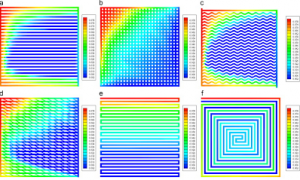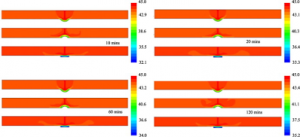Mixing, separation and reaction engineering
High performance microreactors have received special attention over the past decade as miniaturization has emerged as a need in industrial and medical applications such as Bio Micro-Electro-Mechanical Systems (Bio-MEMS) and lab-on-a-chip Microsystems. It is well-known that small scale devices such as microreactors (in the order of sub millimeter) can improve heat and mass transfer rates significantly due to smaller diffusion path. This enables us to precisely and selectively control reaction environment in microreactors. Such devices can reduce the risk inherent in extreme reaction conditions, e.g. highly exothermic reactions or explosive reactions.
In microreactors two phenomena occur: mixing and reaction. Good mixing performance in a microreactor is an important design factor. The reaction process can be slowed down by local shortage of one of the reactants as a result of poor mixing. In order to enhance mixing, two approaches can be implemented, i.e., passive and active mixing enhancement. For the former, we can make use of the energy of the flow itself by, for example, designing the shape of the channel to stretch and fold the flow, and generate chaotic advection. These can increase the interfacial area between fluid segments thus created and by reducing the diffusion length for heat and mass transport without any additional equipment or energy added to the system. In an active micromixer, on the other hand, external forces and artifact is added to help to enhance mixing. This external force can be introduced using mechanical rotation, pulsation of the flow, vibration or electrical excitation of the flow and microwaves. Our group aims to study fundamental and applied aspect of mixing and reaction in various geometries, reaction types etc to improve the reaction performance, minimizing operating cost and catalyst requirement.
Relevant publications:
- B. Mohan, J. Puqing, A.P. Sasmito*, J.C. Kurnia, S.V. Jangam, A.S. Mujumdar, Energy efficient novel heterogeneous gaseous T-junction micro-reactor design utilizing inlet flow pulsation, Industrial & Engineering Chemistry Research (2014) in press, DOI:10.1021/ie500797f.
- N. Solehati, J. Bae*, A.P. Sasmito, Numerical Investigation of Mixing Performance in Microchannel T-junction with Wavy Structure, Computers & Fluids 2014;96:10-19.
- H. An, A. Li, A.P. Sasmito*, J.C. Kurnia, S.V. Jangam, A.S. Mujumdar, Computational Fluid Dynamics (CFD) Analysis of Microreactors Performance: Effect of Geometric Configurations, Chemical Engineering Science 2012;75:85-95.
- M. Shaker, H. Ghaedamini, A.P. Sasmito*, J.C. Kurnia, S.V. Jangam, A.S. Mujumdar, Numerical Investigation of Laminar Mass Transport Enhancement in Heterogeneous Gaseous Microreactors, Chemical Engineering Processing: Process Intensification 2012;54:1-11.
- A.P. Sasmito*, J.C. Kurnia, A.S. Mujumdar, Numerical Evaluation of Transport Phenomena in a T-junction Micro-reactor with Coils of Different Configurations, Industrial & Engineering Chemistry Research 2012;51:1970-1980.
Drying and dewatering
Drying is the most common but energy-intensive process for preserving most of the materials. It is considered as an essential operation in major industries; for example, chemical, agricultural, pulp and paper, biotechnology, food, polymer, ceramic, pharmaceutical, mineral processing, and wood processing industries – to name but a few. Therefore, drying has attracted much attention from both industry and academia. According to the literatures, over 400 types of dryers have been reported and 100 distinct types are commercially available. Various drying methods are available for different materials.
During drying, two transfer processes – heat and mass – occur simultaneously in both inside material and outside in the surrounding. The energy transfer occurs as heat is transferred from the surrounding environment (drying air in convective drying) into the drying substrate while mass transfer occurs as the moisture moves from the drying substrate to the surrounding environment. As such, the rate at which the drying process accomplished is determined by the rate of heat and mass transfer. In order to improve drying rate, either mass transfer rate or heat transfer rate or both transfer rates have to be improved. One promising method is by implementing impinging-jet which offers higher heat and mass transfer rates.
Relevant publications:
- J.C. Kurnia*, A.P. Sasmito, P. Xu, A.S. Mujumdar, Performance and potential energy saving of thermal dryer with intermittent impinging jet, Applied Thermal Engineering 113 (2017) 246-258
- J.C. Kurnia*, A.P. Sasmito, W. Tong, A.S. Mujumdar, Energy-Efficient Thermal Drying Using Impinging-Jets with Time-Varying Heat Input – A Computational Study, Journal of Food Engineering 2013;114:269-277.
- J.C. Kurnia, A.P. Sasmito, W. Tong, A.S. Mujumdar, Conjugate Model for Drying of Thin Slabs Using Impinging Jets, book chapter in: Drying of Foods, Vegetables and Fruits – Volume 3, edited by S.V. Jangam, C.L. Law and A.S. Mujumdar, TPR Group, Singapore, 2011, ISBN: 978-981-08-9426-9.



